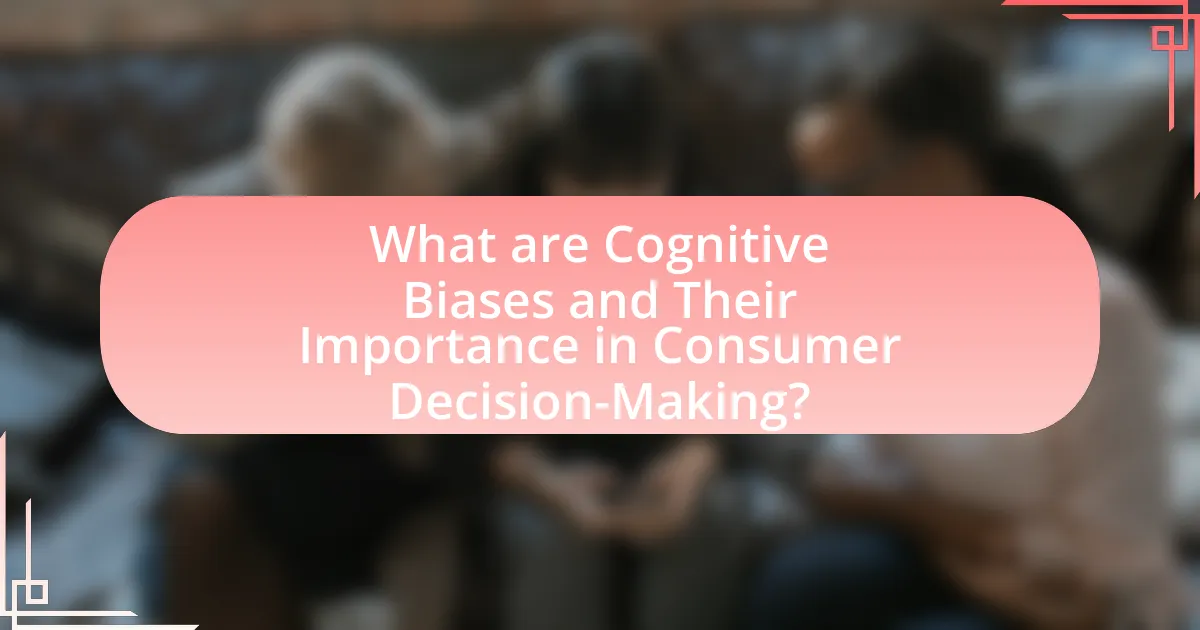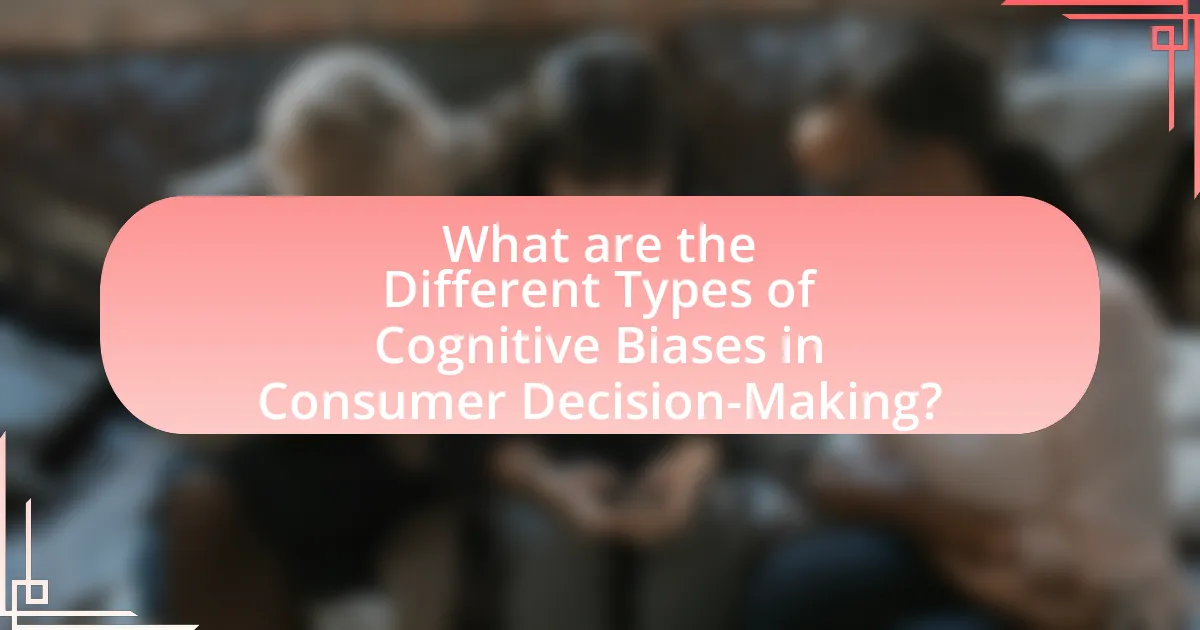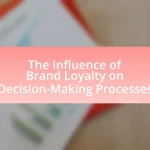Cognitive biases are systematic deviations from rational judgment that significantly impact consumer decision-making. This article explores how biases such as confirmation bias, anchoring bias, and loss aversion shape perceptions of value and influence purchasing behavior. It highlights the importance of understanding these biases for marketers to tailor effective strategies that enhance consumer engagement and brand loyalty. Additionally, the article discusses practical approaches for businesses to adapt to cognitive biases and improve the purchasing process, ultimately empowering consumers to make more informed decisions.

What are Cognitive Biases and Their Importance in Consumer Decision-Making?
Cognitive biases are systematic patterns of deviation from norm or rationality in judgment, which significantly influence consumer decision-making. These biases affect how consumers perceive information, evaluate options, and ultimately make purchasing decisions. For instance, the anchoring bias leads consumers to rely heavily on the first piece of information they encounter, such as a product’s initial price, which can skew their perception of value. Research by Tversky and Kahneman highlights that cognitive biases can lead to irrational choices, demonstrating their critical role in shaping consumer behavior. Understanding these biases allows marketers to tailor strategies that align with consumer psychology, enhancing engagement and sales effectiveness.
How do cognitive biases influence consumer behavior?
Cognitive biases significantly influence consumer behavior by affecting decision-making processes and perceptions of value. These biases, such as confirmation bias and anchoring, lead consumers to favor information that aligns with their pre-existing beliefs or to rely heavily on the first piece of information encountered, respectively. For instance, studies show that consumers often overvalue products that are presented with a higher initial price due to anchoring, which skews their perception of subsequent discounts. Additionally, confirmation bias can cause consumers to seek out reviews that support their initial choice, reinforcing their purchasing decisions. This interplay of cognitive biases shapes how consumers evaluate options, ultimately impacting their buying behavior and brand loyalty.
What are the most common cognitive biases affecting consumers?
The most common cognitive biases affecting consumers include confirmation bias, anchoring bias, and loss aversion. Confirmation bias leads consumers to favor information that confirms their pre-existing beliefs, impacting their purchasing decisions. Anchoring bias occurs when consumers rely heavily on the first piece of information encountered, such as an initial price, which can skew their perception of value. Loss aversion describes the tendency for consumers to prefer avoiding losses over acquiring equivalent gains, influencing their choices and risk assessments in buying scenarios. These biases are well-documented in behavioral economics, illustrating how they shape consumer behavior and decision-making processes.
How do cognitive biases shape perceptions of value and quality?
Cognitive biases significantly influence perceptions of value and quality by distorting how individuals evaluate products and services. For instance, the anchoring bias leads consumers to rely heavily on the first piece of information they encounter, such as an initial price, which can skew their perception of what constitutes a fair value. Research by Tversky and Kahneman (1974) illustrates that individuals often make decisions based on this initial anchor, affecting their overall assessment of quality and worth. Additionally, the confirmation bias causes consumers to favor information that supports their pre-existing beliefs about a product, further shaping their perception of its value. This interplay of cognitive biases ultimately results in subjective evaluations that may not align with objective quality metrics.
Why is understanding cognitive biases crucial for marketers?
Understanding cognitive biases is crucial for marketers because these biases significantly influence consumer decision-making processes. Marketers who grasp these biases can tailor their strategies to align with how consumers think and behave, ultimately enhancing engagement and conversion rates. For instance, the anchoring bias demonstrates that consumers rely heavily on the first piece of information they encounter, which can be leveraged in pricing strategies to make offers appear more attractive. Research by Tversky and Kahneman highlights that cognitive biases shape judgments and decisions, underscoring the importance of this understanding in crafting effective marketing campaigns.
How can marketers leverage cognitive biases to enhance advertising strategies?
Marketers can leverage cognitive biases by designing advertisements that align with these psychological tendencies, thereby influencing consumer behavior. For instance, the scarcity bias can be utilized by promoting limited-time offers, which creates a sense of urgency and increases perceived value. Research indicates that consumers are more likely to purchase items they believe are in limited supply, as demonstrated in a study published in the Journal of Consumer Research, where scarcity led to a 50% increase in sales for limited-edition products. Additionally, the anchoring effect can be employed by presenting a higher-priced item first, making subsequent items appear more affordable, which can enhance the likelihood of purchase. This strategy is supported by findings from behavioral economics, which show that initial price exposure significantly impacts consumer perception of value. By integrating these cognitive biases into advertising strategies, marketers can effectively drive consumer engagement and increase sales.
What role do cognitive biases play in brand loyalty?
Cognitive biases significantly influence brand loyalty by shaping consumer perceptions and decision-making processes. These biases, such as confirmation bias and the halo effect, lead consumers to favor brands that align with their pre-existing beliefs or positive associations. For instance, confirmation bias causes consumers to seek information that supports their preferred brand, reinforcing loyalty. Research indicates that 70% of consumers remain loyal to brands they perceive positively, often due to the halo effect, where a single positive experience enhances overall brand perception. Thus, cognitive biases play a crucial role in fostering and maintaining brand loyalty through the manipulation of consumer thought processes and emotional responses.

What are the Different Types of Cognitive Biases in Consumer Decision-Making?
Cognitive biases in consumer decision-making include several types that influence how consumers perceive information and make choices. Key types of cognitive biases are confirmation bias, where consumers favor information that confirms their pre-existing beliefs; anchoring bias, which occurs when consumers rely heavily on the first piece of information encountered; and availability heuristic, where consumers judge the likelihood of events based on how easily examples come to mind. Other notable biases include the bandwagon effect, where individuals adopt behaviors or beliefs because others do, and loss aversion, which leads consumers to prefer avoiding losses over acquiring equivalent gains. These biases significantly impact purchasing behavior and brand loyalty, as evidenced by research indicating that consumers often make irrational decisions based on these cognitive shortcuts.
What is the anchoring bias and how does it affect purchasing decisions?
Anchoring bias is a cognitive bias where individuals rely heavily on the first piece of information encountered (the “anchor”) when making decisions. This bias significantly affects purchasing decisions by influencing consumers’ perceptions of value and pricing. For example, if a consumer sees a product priced at $100 and then sees a similar product priced at $70, the initial $100 price serves as an anchor, making the $70 price appear more attractive, even if the actual value of the second product is lower. Research by Tversky and Kahneman in 1974 demonstrated that individuals often make estimates based on initial information, highlighting the impact of anchoring on decision-making. Thus, marketers can leverage anchoring bias by strategically presenting higher initial prices to enhance the perceived value of discounted products.
How can consumers recognize and mitigate the anchoring bias?
Consumers can recognize and mitigate the anchoring bias by being aware of initial information that influences their decisions and actively seeking additional data before making choices. Awareness of the anchoring effect, which occurs when individuals rely too heavily on the first piece of information encountered, allows consumers to question the relevance of that information. Research indicates that when consumers are prompted to consider alternative price points or options, they are less likely to be swayed by initial anchors. For example, a study published in the Journal of Consumer Research by Tversky and Kahneman demonstrates that individuals adjust their estimates based on initial values, highlighting the importance of critical evaluation of first impressions. By consciously evaluating multiple sources of information and considering a range of options, consumers can reduce the impact of anchoring bias on their decision-making.
What strategies can marketers use to exploit the anchoring bias?
Marketers can exploit the anchoring bias by setting a high initial price for a product, which serves as a reference point for consumers. This strategy influences consumers’ perception of value, making subsequent prices appear more attractive. For example, if a luxury watch is initially priced at $1,000 and later offered at a discounted price of $700, consumers are likely to perceive the $700 price as a good deal due to the initial anchor. Research by Tversky and Kahneman (1974) demonstrates that individuals rely heavily on the first piece of information they receive when making decisions, confirming the effectiveness of this strategy in shaping consumer behavior.
How does the confirmation bias impact consumer choices?
Confirmation bias significantly impacts consumer choices by leading individuals to favor information that confirms their pre-existing beliefs while disregarding contradictory evidence. This cognitive bias can result in consumers selectively seeking out product reviews or advertisements that align with their preferences, ultimately reinforcing their purchasing decisions. For instance, a study published in the Journal of Consumer Research found that consumers are more likely to remember and trust positive reviews of a product they already favor, while negative reviews are often overlooked. This behavior can skew market perceptions and influence brand loyalty, as consumers become entrenched in their choices based on biased information processing.
What are examples of confirmation bias in consumer behavior?
Confirmation bias in consumer behavior manifests when individuals favor information that aligns with their pre-existing beliefs or preferences. For example, a consumer who believes a specific brand is superior may only seek out positive reviews and ignore negative feedback, reinforcing their initial opinion. Additionally, when purchasing a product, consumers might focus on features that confirm their choice while disregarding aspects that contradict it, such as overlooking a competitor’s better warranty. Research shows that this bias can lead to brand loyalty, as consumers are less likely to consider alternatives that challenge their established views, ultimately affecting their purchasing decisions.
How can brands address confirmation bias in their marketing efforts?
Brands can address confirmation bias in their marketing efforts by presenting diverse perspectives and counterarguments that challenge existing consumer beliefs. By incorporating data and testimonials that highlight alternative viewpoints, brands can encourage consumers to reconsider their preconceived notions. Research indicates that when consumers are exposed to information that contradicts their beliefs, they are more likely to engage in critical thinking and reassess their choices. For example, a study published in the Journal of Consumer Research found that presenting consumers with balanced information led to more informed decision-making, ultimately reducing the impact of confirmation bias.

How Can Businesses Adapt to Cognitive Biases in Consumer Decision-Making?
Businesses can adapt to cognitive biases in consumer decision-making by implementing strategies that acknowledge and leverage these biases. For instance, businesses can utilize the anchoring effect by presenting initial price points that influence consumers’ perceptions of value, as demonstrated by research showing that consumers often rely heavily on the first piece of information they receive. Additionally, employing social proof, such as customer testimonials and reviews, can effectively counteract biases like the bandwagon effect, where individuals are influenced by the actions of others. Furthermore, simplifying choices can help mitigate decision fatigue, a common bias that can overwhelm consumers, as evidenced by studies indicating that fewer options lead to higher satisfaction and better decision-making. By understanding and strategically addressing these cognitive biases, businesses can enhance consumer engagement and drive sales.
What strategies can businesses implement to counteract cognitive biases?
Businesses can implement strategies such as training employees on cognitive biases, utilizing data-driven decision-making, and designing choice architectures to counteract cognitive biases. Training employees enhances awareness of biases like confirmation bias and anchoring, enabling them to make more objective decisions. Data-driven decision-making reduces reliance on subjective judgments by emphasizing empirical evidence, which can mitigate biases such as overconfidence. Additionally, designing choice architectures, such as simplifying options or presenting information in a clear manner, can help guide consumer decisions and reduce the impact of biases like choice overload. These strategies are supported by research indicating that awareness and structured decision-making processes can significantly improve decision quality in business contexts.
How can businesses create a more transparent purchasing process?
Businesses can create a more transparent purchasing process by providing clear and accessible information about products, pricing, and policies. This includes detailing product specifications, pricing breakdowns, and return policies on their websites and marketing materials. Research indicates that transparency in pricing can reduce cognitive biases, such as the anchoring effect, where consumers rely heavily on the first piece of information they encounter. For example, a study published in the Journal of Consumer Research found that when consumers are presented with transparent pricing, they are more likely to make informed decisions, leading to higher satisfaction and trust in the brand.
What role does consumer education play in reducing cognitive biases?
Consumer education plays a crucial role in reducing cognitive biases by equipping individuals with the knowledge and skills necessary to make informed decisions. By understanding common cognitive biases, such as confirmation bias or anchoring, consumers can recognize when these biases may influence their choices. Research indicates that informed consumers are better at evaluating information critically, leading to more rational decision-making processes. For instance, a study published in the Journal of Consumer Research found that consumers who received education on cognitive biases were significantly less likely to fall prey to misleading marketing tactics. This demonstrates that consumer education not only enhances awareness but also fosters critical thinking, ultimately mitigating the effects of cognitive biases in decision-making.
What best practices should marketers follow to effectively engage consumers?
Marketers should utilize personalization, leverage social proof, and create a sense of urgency to effectively engage consumers. Personalization enhances consumer experience by tailoring messages and offers to individual preferences, which studies show can increase engagement rates by up to 20%. Leveraging social proof, such as testimonials and user-generated content, builds trust and influences consumer behavior, as 79% of consumers trust online reviews as much as personal recommendations. Creating a sense of urgency through limited-time offers or scarcity tactics prompts quicker decision-making, capitalizing on the fear of missing out, which can significantly boost conversion rates.
How can storytelling be used to mitigate cognitive biases?
Storytelling can mitigate cognitive biases by providing relatable narratives that challenge preconceived notions and emotional responses. Through engaging stories, individuals can reframe their understanding of situations, leading to more balanced decision-making. For instance, research indicates that narratives can activate different brain regions compared to analytical thinking, promoting empathy and reducing biases such as confirmation bias. A study by Green and Brock (2000) found that individuals who engaged with stories were more likely to change their attitudes and beliefs, demonstrating storytelling’s effectiveness in altering cognitive frameworks.
What are the benefits of using social proof in marketing strategies?
The benefits of using social proof in marketing strategies include increased consumer trust, enhanced credibility, and improved conversion rates. Social proof leverages the psychological tendency of individuals to look to others for guidance in their decision-making processes. For instance, studies show that 70% of consumers are influenced by online reviews and testimonials when making purchasing decisions, indicating that social proof significantly impacts consumer behavior. Additionally, incorporating social proof, such as user-generated content or endorsements from influencers, can lead to a 12.5% increase in conversion rates, demonstrating its effectiveness in driving sales.
How can consumers make better decisions by understanding cognitive biases?
Consumers can make better decisions by understanding cognitive biases, as this awareness allows them to recognize and mitigate irrational influences on their choices. Cognitive biases, such as confirmation bias and anchoring, can distort perception and lead to suboptimal decisions. For instance, research by Tversky and Kahneman highlights how anchoring can cause individuals to rely too heavily on the first piece of information encountered, skewing their judgment. By identifying these biases, consumers can adopt strategies like seeking diverse perspectives and questioning initial impressions, ultimately leading to more informed and rational decision-making.
What tips can consumers use to recognize their own biases?
Consumers can recognize their own biases by actively reflecting on their decision-making processes and seeking diverse perspectives. Engaging in self-reflection allows individuals to identify patterns in their choices that may be influenced by biases, such as confirmation bias or anchoring bias. Additionally, consulting with others who have different viewpoints can highlight blind spots and challenge preconceived notions. Research indicates that individuals who engage in perspective-taking are better equipped to recognize their biases, as demonstrated in studies published in the Journal of Personality and Social Psychology, which show that exposure to diverse opinions can reduce bias in decision-making.
How can consumers apply knowledge of cognitive biases to improve their purchasing decisions?
Consumers can apply knowledge of cognitive biases to improve their purchasing decisions by recognizing and mitigating the influence of these biases on their behavior. For instance, understanding the anchoring bias, where individuals rely heavily on the first piece of information encountered, allows consumers to compare prices more effectively and avoid overpaying. Research by Tversky and Kahneman highlights how initial price points can skew perceptions of value, indicating that awareness of this bias can lead to more informed choices. Additionally, recognizing the confirmation bias, which leads consumers to favor information that confirms their pre-existing beliefs, can encourage them to seek diverse opinions and data before making a purchase. This approach can enhance decision-making quality and lead to better satisfaction with purchases.

